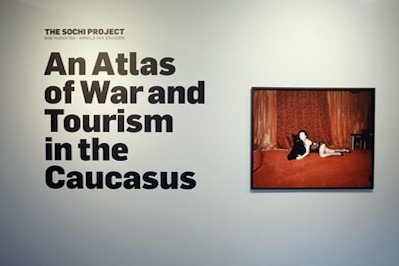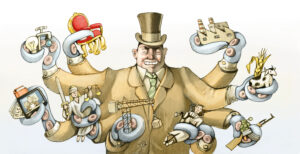The Sochi Project
This remarkable photo book explores the impoverished people and conflict-ridden region surrounding Sochi, home of the 2014 Olympic Winter Games It's not what Putin wants the world to see This remarkable photo book explores the impoverished and conflict-ridden region surrounding Sochi, home of the 2014 Olympic Winter Games .
“The Sochi Project: An Atlas of War and Tourism in the Caucasus” A book by Rob Hornstra and Arnold van Bruggen
“The Sochi Olympic games in the subtropics — it’s a fraud.”
So said liberal Russian politician Boris Nemtsov, an outspoken critic of Russian President Vladimir Putin, in 2009. Nemtsov expresses just one of the many problems plaguing the controversial leader since being awarded the XXII Winter Games in 2007.
Heightened security and threats of boycotts have been an Olympic concern since the killing of 11 Israeli athletes at the 1972 Munich games. The December bombings in Volgograd, about 400 miles from Sochi, along with a recent car explosion and the discovery of six dead bodies in nearby Stavropol province, have the world wondering in particular if Putin can contain the threat of violence. This comes on top of human rights violations, anti-gay laws, displaced citizens and free-speech issues. The tip of the iceberg: the skyrocketing $50 billion price tag, rife with corruption.
Why the International Olympic Committee chose Sochi, a seaside resort in close proximity to the volatile North Caucasus, a poor mountainous region with a history of war and armed conflict, is a mindboggling mystery. I can only surmise the IOC members fell under the charismatic spell of Putin’s gold-medal-worthy pitch speech to them in Guatemala.
The new photo book “The Sochi Project: An Atlas of War and Tourism in the Caucasus” by Dutch journalists Rob Hornstra and Arnold van Bruggen tells the comprehensive, grass-roots story of Sochi and its colorful characters.
This remarkable tome is the culmination of an ambitious five-year project examining the impoverished region surrounding Sochi. It reveals a very different reality from the facade presented by Putin’s publicity machine.
After Sochi was awarded the 2014 Olympic Winter Games in 2007, writer van Bruggen approached photographer Hornstra to collaborate on a long-term project on Sochi.
Although Hornstra had recently published two books on Russia, “Communism & Cowgirls” and “101 Billionaires,” he was game.
Their process of “slow journalism” is very similar to documentary filmmaking. “Journalism focuses on what is happening and slow journalism is more about why these things are happening,” Hornstra explained in an interview with Vice.
After receiving a grant, a viable plan was hatched. They would revisit the same places and people over the course of five years leading up to the games, creating an in-depth and honest progress report. They broke down the massive project into subcultures and regions.
Through Kickstarter and pre-sales they were able to publish several smaller books on specific topics such as sanitariums, the disputed territory of Abkhazia and Sochi lounge singers, which are included as chapters in the final 6 pound book published by Aperture.
The stories here are not the usual heartwarming athlete profiles that television audiences are used to. Hornstra and van Bruggen focus on the lives of the people and lands affected by the Olympics. Some are hopeful about the prospect of economic prosperity, others disillusioned and angry about the change and corruption.
Hornstra’s portraits combined with van Bruggen’s detailed and often entertaining text put the thoroughly researched history of each category and subject into context. Their first person experiences give a fuller understanding of this complicated region. It’s a masterful achievement.
Along with 311 color photos are interviews, profiles, regional maps and a personal travel log.
There are no action shots of ice skaters landing a Triple Salchow or good-looking snowboarders shredding a half pipe. Instead we have Hornstra’s poignant portraits of the aged faces of proud WWII vets clad in Soviet era uniforms, living out their golden years in rundown buildings, or an image of a courageous policeman who shielded his comrades in a rebel attack leaving him with one arm, one eye and no legs to take care of his family.
On their first trip to Sochi in 2009, Hornstra and van Bruggen began with a look inside sanitariums, an important Russian tradition. It was under Soviet rule that Sochi was transformed into a health mecca for the elite. Cosmonauts, actors and even Leonid Brezhnev were frequent guests to these spas that dotted the Black Sea coast. A holiday trip to Sochi was also considered a reward for laborers for their hard work or to recuperate from an injury.
A photo of a smirking 77-year-old former miner, Mikhail Pavelivich Karabelnikov, in teal Speedos and a captain’s hat, accompanied by his tale of traveling 1,800 miles every year by train to reach Sochi, attests to the continued popularity, among retirees, of the vacation paradise. Younger people, however, see the sanitoria as outmoded and a reminder of old Soviet ways.
In order to fully understand the experience of the sanitoria, Hornstra and van Bruggen went undercover, immersing themselves like actors preparing for a role. For 12 days they mingled among the elderly at the popular neoclassical Sanitarium Metallurg, and were subjected to electric clay treatments, mineral baths, sunbathing days, karaoke nights and gorging on less than healthy fare — meatballs, rice and cake — three times a day.Their study of Abkhazia, just five miles from the Olympic village, was far from a relaxing retreat. After the dissolution of the Soviet Union in 1991, several ethnic conflicts broke out in the former republics, including the 2008 war between Georgia and separatists Abkhazia and South Ossetia, which have since gained their own de facto independence.
Bombed out hotels and apartments — many with no gas, running water or electricity — remain standing. Families continue to live in these crumbling structures. Because the buildings have been deemed habitable, the residents have been unable to collect compensation from the Russian government.
“In Stalin’s days everything was well organized,” 77-year South Ossetia resident Zaur Bigulaev recounts in “The Sochi Project,” sharing his nostalgia for the Soviet era.
Many villages in the seven republics that comprise the troubled Northern Caucasus, a day’s drive over the mountains from Sochi, suffer high unemployment, isolation and an eroding infrastructure. Despite serene landscapes with waterfalls and sweeping valleys, the region is a well-known breeding ground for terrorists and Islamic separatists groups. In the plains below lie Chechnya and Dagestan, from where Boston Marathon bombing suspects Tamerlan and Dzhokhar Tsarnaev hail. One of the female bombers responsible for the 2010 Moscow subway attacks was from a nearby village. Residents are afraid to go out after dark. Fathers and sons are taken from their homes never to be seen again.
Closer to Sochi, construction on Olympic facilities was slow and disorganized. Workers, consisting of a large contingent of migrants, spoke of being owed six months’ back pay and living in deplorable conditions. One photo shows a dilapidated cow shed where some slept, while others were forced to sleep in fields. Many were afraid to speak up and were not even sure who was in charge.
In 2009 van Bruggen described the Sochi airport “like a bus stop. … A single busy coastal road not designed to handle the traffic, resulting in daily gridlock and endless traffic jams.” Since then the $8 billion Adler-Krasnaya Polyana Highway and Railway has been built in the area.
Hornstra and van Bruggen’s travels took them to prisons, schools, museums, discos, a 19th century post office, numerous memorials and abandoned factories as well as several unplanned visits to police stations.
In 2011 the pair drove to the village of Shatoy, in Chechnya, to check on the status of the mayor’s proclamation to transform it into the “Switzerland of Chechnya.” They were apprehended and arrested by the FSB (Russia’s Federal Security Service) at an Army checkpoint near the village. They were interrogated and threatened with deportation, extortion and forced to pay fines to stay in the country. This was one of several times they were arrested.
The behind-the-scenes travel log details the good, the bad and the ugly of their journey, including van Bruggen’s near escape from a “Marathon Man”-like trip to the dentist. Despite being foreigners, they were invited into private homes and treated as guests. Dining on shashlik (grilled goat) and imbibing countless glasses of vodka and chacha (a potent grape brew) allowed them intimate access and honest conversations. This type of slow form reportage, reminiscent of Depression-era photographers Walker Evans and Dorothea Lange, is to be praised and relished.
Sadly, a few of the people the pair befriended and interviewed were either killed or went missing. Others took the if-you-can’t-beat-them-join-them approach, working Olympic-related jobs.
It’s difficult not to feel sympathy and disbelief while looking at Hornstra’s interior shots of living rooms with peeling paint, cracked walls and sparse furnishings.
The fantastical stories and compelling images collected in “The Sochi Project” will serve as a record of this region and its people unlike any other. I find myself rooting for an uneventful and successful Olympics, not for Putin’s sake, but for all those solemn faces that just want to live in peace.
A selection of photographs from “The Sochi Project” is on display at the DePaul Art Museum in Chicago through March 24 and at FotoMuseum in Antwerp, Belgium, through March 2.
Liesl Bradner is a freelance writer and regular contributor to the Los Angeles Times covering books, arts and entertainment.
Your support matters…Independent journalism is under threat and overshadowed by heavily funded mainstream media.
You can help level the playing field. Become a member.
Your tax-deductible contribution keeps us digging beneath the headlines to give you thought-provoking, investigative reporting and analysis that unearths what's really happening- without compromise.
Give today to support our courageous, independent journalists.






You need to be a supporter to comment.
There are currently no responses to this article.
Be the first to respond.